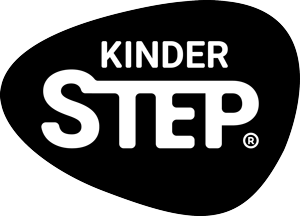FAQ
These are the questions we are asked the most about KinderStep®. However, if you have some that are not adressed, feel free to contact us—we will be pleased to go in greater detail.
Why is it essential to have two steps?
Why won't a simple free-standing step stool do the job?
Where can KinderStep be installed?
Is it necessary to improve sink access if hand sanitizers and wipes are provided?
Does KinderStep's mechanism involve gas springs or other short lifecycle components?
Does KinderStep obstruct tall people using the sink?
Can KinderStep be installed outside?
Is KinderStep recyclable?
What is KindStep's antislip tread made of?
Is KinderStep chemically resistant?
Why does KinderStep support 1000 lbs (450 kg) and how does it do it?
What kind of anchors hold KinderStep in place?
Is KinderStep easy to clean?
Why is an enclosed base so important?
Can I remove KinderStep's body from its base, say to access the plumbing behind?
Where is KinderStep manufactured?
In the midst of a recession, why should acquiring KinderSteps still be a priority?
Why is it essential to have two steps?
Smaller children and people of short stature can hardly reach a height of 25 cm (10") in one step. So for them, two steps are indispensable. For taller users, two reasonably spaced steps are more welcoming, accessible, and comfortable than a single higher step.
Why won't a simple free-standing step stool do the job?
As convenient as a free-standing stool may be in the home, in public facilities these wooden or plastic stools look cheap and negligent. Since they are not fixed to the floor, they have led to accidents. Rarely clean, these stools can be misplaced or stolen.
Where can KinderStep be installed?
KinderStep was created for public restrooms but they are also suitable for use with water fountains, wall-mounted hairdryers, and basically any place where little ones need a leg up. KinderStep can even be installed in private homes.
Is it necessary to improve sink access if hand sanitizers and wipes are provided?
Yes. Even when other hand-cleaning methods are available, health authorities are clear that only soap and water can cleanse your hands after going to the bathroom.
Does KinderStep's mechanism involve gas springs or other short lifecycle components?
No. KinderStep's patented mechanism relies on heavy-duty custom-made torsion springs that are built to last over one million cycles. Our confidence in the longevity of KinderStep is one of the reasons why we offer a 10-year warranty that covers the whole product.
Does KinderStep obstruct tall people using the sink?
No. KinderStep is self-retracting and therefore always kept out of the way. We tested KinderStep with tall people who have big feet and there are no problems!
Can KinderStep be installed outside?
Yes. KinderStep is weather resistant and is designed for inside and outside use.
Is KinderStep recyclable?
Yes. KinderStep is made of metal and polyethylene, both of which are recyclable. In addition, through our partnership with Plastic Bank, we finance the recovery of as much ocean bound plastic, as polyethylene we produce.
What is KindStep's antislip tread made of?
KinderStep's antislip tread is made from a rubberized material with a coefficient of friction of 1.0. KinderStep's designers went above and beyond the strictest norms to provide a rare combination of grip and softness for the skin that will be appreciated by little barefoot swimmers in aquatic facilities.
Is KinderStep chemically resistant?
Yes. KinderStep resists the salt of coastal regions as well as the chlorine of poolside environments.
Why does KinderStep support 1000 lbs (450 kg) and how does it do it?
KinderStep supports 1000 lb (450 kg) to be ultra resistant to vandalism. How is this achieved? The proverb says, "Better bend than break" and it's true. KinderStep's strength resides in its plasticity; it bends, it does not break. Also, KinderStep is not cantilevered, meaning that the load is distributed throughout the base and the front foot.
What kind of anchors hold KinderStep in place?
Common Tapcon®-type screws anchor KinderStep to the floor. Quick and easy to install, they are not challenging like other types of masonry anchors and they're strong enough for the weak forces exerted on KinderStep's anchoring points.
Is KinderStep easy to clean?
Absolutely. KinderStep, with its rounded profile and dissimulated anchors, is free of cavities or protruding bolt heads. This makes KinderStep very easy to keep clean and disinfect. A quick mopping over and under will do the trick! The inner configuration drains water out, so pressure washers can be used to keep the step clean.
Why is an enclosed base so important?
If the bolts in the base were left uncovered, they would get dirty and catch on unsightly mop fibers. By hiding them in the enclosed base, the unit looks tidier and is easier to clean.
Can I remove KinderStep's body from its base, say to access the plumbing behind?
Yes. It takes one minute to remove the body from the base and gain access to the area behind the KinderStep. Removing the base takes one more minute.
Where is KinderStep manufactured?
KinderStep is manufactured in Canada, one of the United States' top trading partners. With 15% of all its exports going to Canada, the U.S. sells more to Canada than to China, Japan, and South Korea combined.
In the midst of a recession, why should acquiring KinderSteps still be a priority?
In light of the current pandemic, handwashing is ever more crucial. People are looking for ways to feel cleaner and healthier, and this is as important outside as inside the home. Offering KinderStep vastly improves customer and citizen experience while promoting public health.
